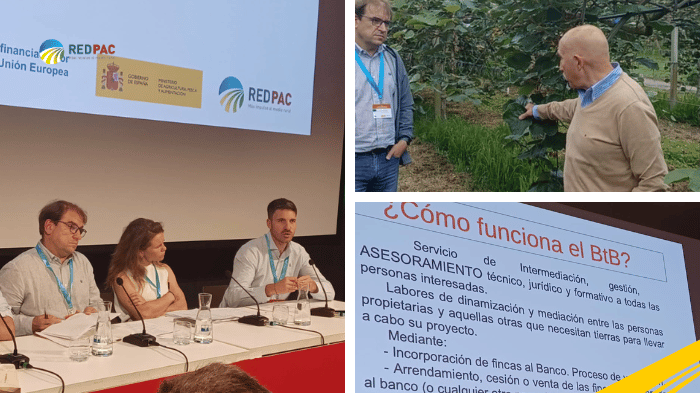
19 de June de 2024
68 stakeholders from the agricultural and rural sectors, including Local Action Groups, met in Avilés (Asturias) on June 11 to present projects, disseminate and highlight LEADER best practices, and discuss some of the limitations young people face in rural and agricultural areas.
- The LEADER experience exchange event: "Land Bank and Generational Change" was held in Avilés (Asturias) and brought together the local action groups of the region along with numerous stakeholders from the agricultural and rural sectors.
- The objective of the meeting was to share experiences regarding generational renewal in the agricultural sector and the promotion of land banks, as well as to disseminate and give visibility to LEADER projects on generational renewal in the agricultural sector and their participation in land banks.
"Trust: that's the key to a functioning land bank." This was one of the conclusions drawn from the LEADER Experience Exchange Session: "Land Banking and Generational Change." that the PAC Network held in Avilés (Asturias) on June 11 at the Niemeyer Center .
Sixty-eight stakeholders from the agricultural and rural sectors, including Local Action Groups (LAGs) , gathered there to present their ongoing projects related to land banks and youth access to them to promote generational renewal. The objectives of the event were to disseminate and raise awareness of LEADER best practices in generational renewal in the agricultural sector and their participation in land banks, as well as to discuss the limitations faced by people living in rural areas, especially young people, in accessing land and the agricultural sector.
These objectives were articulated around a program interspersed with presentations and round tables, which were accompanied in the second afternoon by visits to fruit and vegetable farms and livestock farms that were examples of good practices in access to land.
Data on access to land
The conference revealed significant data, such as the projection that 11% of European agricultural land is at risk of abandonment between 2015 and 2030: this represents more than 20 million hectares of land. These calculations are based on the estimated current underutilized area in Europe:
- 198.196 abandoned hectares
- 2,200,000 hectares left unused
Of all the Member States, Spain and Poland are the countries facing the greatest challenge related to land abandonment.
In Spain's specific case, the total underutilized area is estimated to be 2.5 million hectares , out of the 25 million hectares registered nationally, i.e., 10% of the area is underutilized.
With this data, the most relevant conclusions that can be drawn are:
- There is currently little incorporation of young people into the agricultural sector
- There is a high retirement rate of farm owners
- Agricultural lands are abandoned
- Low level of implementation of land banks
Thus, the tools that seem most appropriate to stop this movement would be:
- Transfer of farms
- Youth facility
- Reversing land abandonment through land banks











